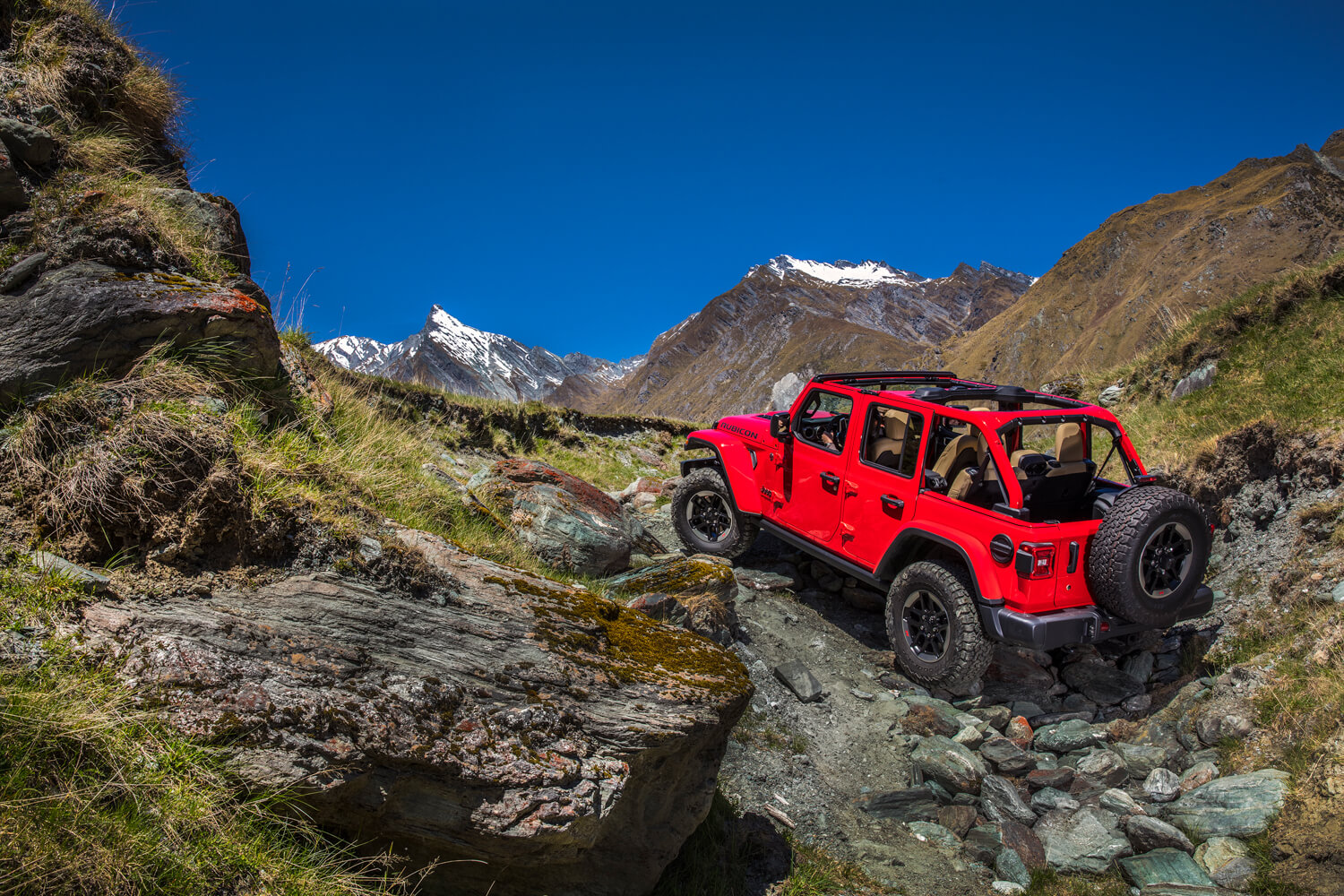
Jeep Wrangler JL Four Cylinder Turbo Versus V6
The new Jeep Wrangler JL is more popular than even its parent company FCA could ever have predicted. Last year Jeep moved a record number of Wranglers—over 240,000 of them. And, the company is on track to meet that number this year, vaulting the Wrangler high onto the podium of best-selling vehicles in America. That’s staggering for a utilitarian 4X4 like the Wrangler. And, the roll-out of juicy Wrangler news is far from over. Soon, America will have its first diesel Wrangler, a JL loaded with the 260 horsepower 3.0-liter V6 pumping out 442 lb-ft of torque. Yep, it’s a great time to be a Jeep enthusiast.
There’s no doubt the JL is a solid leap ahead of the JK in terms of refinement, capability, speed, and efficiency. But every JL buyer now has a big choice to make: keep the standard V6 or upgrade to the turbocharged four-cylinder? The horsepower and torque numbers for these two engines are close. But we wanted to know which is the one to have. So, we borrowed a $48,650 2018 Wrangler Unlimited Rubicon V6 with a manual transmission and put that vehicle through our usual battery of tests. Later, we spent a week with a $55,760 2019 Unlimited Rubicon equipped with the 2.0-liter four-cylinder turbo eTorque engine and 8-speed automatic and put that Jeep through the very same tests. The techy-new four-cylinder is the more expensive option, but is it worth the extra dough? Let’s find out.
The Hardware
Aside from the engines and transmissions, these two Wranglers are identical. The JL uses a fully-boxed ladder frame that’s constructed from 80 percent high-strength steel. It’s stronger than the old JK frame, with an 18 percent jump in torsional stiffness. And, because of the increase in high-strength steel, engineers could use less of it shedding a full 100 pounds from the frame compared to a JK. And the frame wasn’t the only place Jeep ditched some weight. The doors, fenders, hood, and windshield frame are aluminum. The tailgate is made from an aluminum outer skin and a magnesium layer on the inside. This saves another 100 pounds over the JK.
Speaking of the JK, one of the areas that Jeep engineers improved upon is the windshield and roll cage. The cage is now part of the windshield frame. The structure is shored up whether the windshield is up or down. Lowering the windshield used to require the removal of 26 bolts. Now it only requires the owner to unfasten four. And that more straightforward procedure could encourage more JL Jeepers to four-wheel with the windshield down.
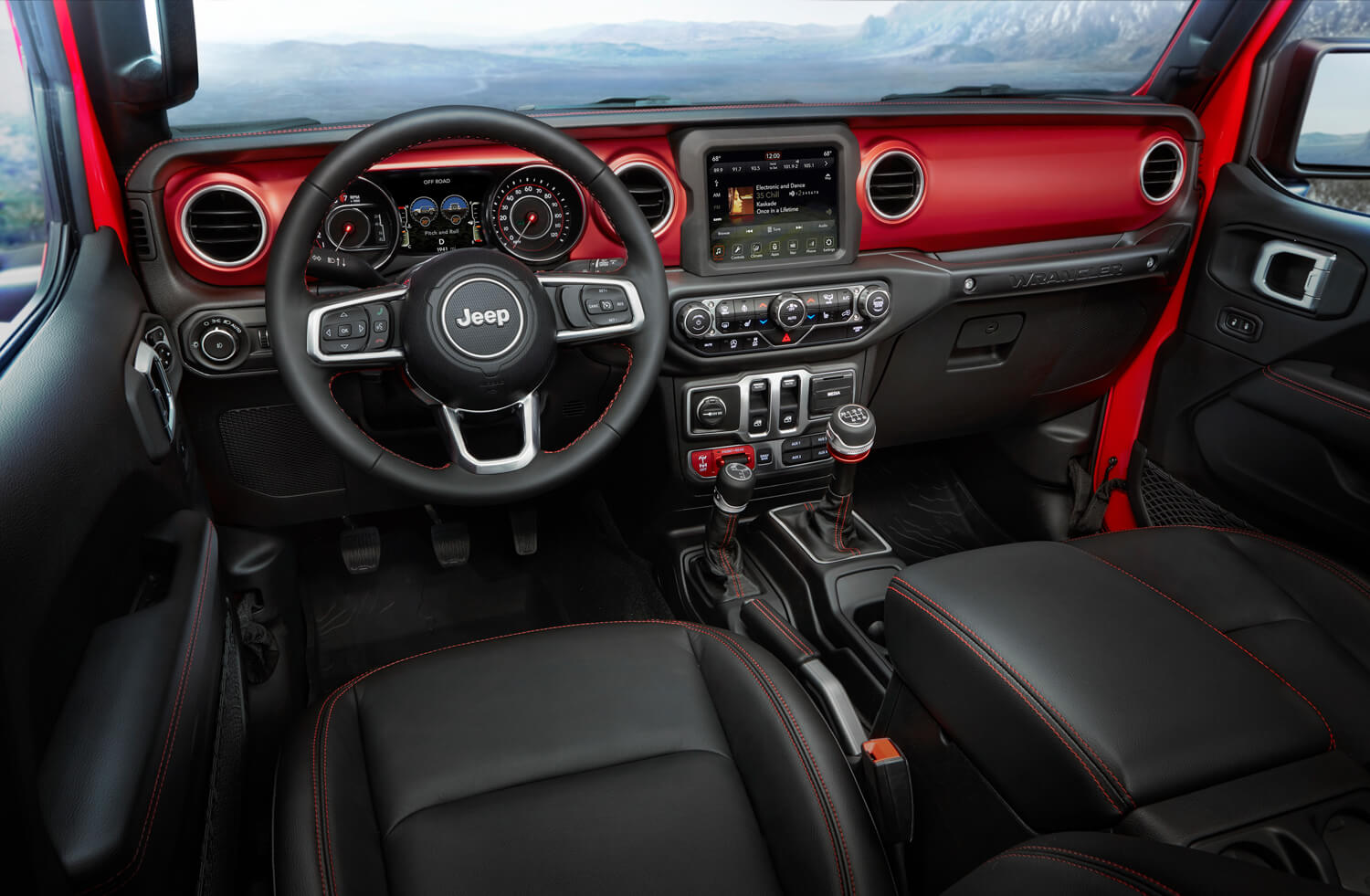
Our white V6 Rubicon left the factory with the standard 3.6-liter Pentastar V6 packing 285 horsepower at 6,400 rpm and 260 lb-ft of torque at 4,800. It’s fitted with stop/start technology. So, when driving in traffic, the engine can shut down and potentially sip less fuel. But don’t worry, there’s a button to defeat the system. And, unlike most Wranglers, which use an 8-speed automatic, this one has a 6-speed manual. The D478 gearbox uses a deep 5.13:1 first gear. So, when the Rubicon shifts into low range with its 4.0:1 transfer case gearing, the crawl ratio (thanks to the 4.10:1 axle gears) hits 84.1:1. That’s remarkable for a factory 4X4 and a jump from the 73.1:1 ratio of the JK Rubicon manual. It’s easily the best 4WD gearing of any new 4×4. This Wrangler’s V6 manual powertrain is rated to deliver 17 mpg city and 23 mpg on the highway.
The blue 4-cylinder Rubicon left Toledo with a four-cylinder turbo under its hood belting out a strong 270 horsepower at 5,350 rpm and a healthy 295 lb-ft of torque at 3,000 rpm. This four-cylinder makes more torque and does it way lower in the rev range than the V6. And this is one very advanced engine with dual overhead cams, aluminum construction, direct fuel injection, variable valve timing, and a twin-scroll turbo.
One could also classify this Jeep as a mild hybrid too. That’s because there’s a small 48-volt electric motor/generator replacing the alternator and providing a boost to the crankshaft thanks to an auxiliary battery mounted under the passenger seat. Jeep says when you leave the line, that boost equates to 71 lb-ft of torque for up to .5 second of thrust time.
Our blue Wrangler uses the newer and far more advanced and complicated engine—the 2.0-liter turbo. The four-cylinder engine might be techy, but it’s also very potent. The optional engine delivers 270 horsepower at 5,350 rpm and 295 lb-ft of torque down at 3,000 rpm. It offers more torque much sooner than the V6.
The four-cylinder turbo comes mated exclusively to an 8-speed. The beefy automatic has a relatively low 4.71:1 first gear and overdrives in the last two gears. And when paired to the Rubicon’s 4.10:1 axle gears, the powertrain delivers an excellent crawl ratio of 77.2:1. And this Wrangler is rated to deliver 22 mpg city and 24 mpg highway—a substantial improvement over the V6. But opting for this powertrain will hike the price by a hefty $3,000 over a manual V6. Our Wrangler is a 2019 model. But for 2020, only the Sahara models will have the eTorque version of this engine available. Rubicons will use a 2.0-liter with the same horsepower and torque ratings but without the complicated mild-hybrid assist system.
The Rubicon axles are identical for both of our Wranglers, and they are beefy units. The JL engineering team listened to customer feedback and shored up the axles in the weak spots. The “Dana 44” axle’s forgings are improved and the tubes themselves are much thicker to resist bending. But the front and rear axles aren’t the same. The front axle uses an 8.26-inch differential and the rear has a stouter 8.66-inch unit. Both come with Tru-Lock electronically activated locking differentials, just like the old Rubicon. The axles themselves are 1.5-inches wider than the JK, and that allowed for a one-foot tighter turning circle. The steering was developed to withstand repeated bashing thanks to the thick 1.73-inch hollow tie rod running across the axle.
The Wrangler Rubicons still uses a five-link coil-sprung suspension at each end, but the roll center has been raised by relocating the track bar. That, according to chief engineer Brian Leyes, cuts down on head toss when traversing rough terrain. The lower control arms have been repositioned on the axle housing compared to a JK, and the spring and damper rates have been re-tuned. Jeep says both help to smooth out the ride. Like Rubicons of the past, these two both have an electronic disconnecting front swaybar to unleash additional wheel travel. Each rig wears 285/70R17 BFGoodrich All-Terrains that measure 33-inches tall. More aggressive mud terrains in that same size are available as an option. Jeep says that with a modest 2-inch lift you can run 35-inch tires.
Aside from their engines and transmissions, the two Wrangler Rubicons are nearly identical. They even both have soft tops. The white V6 manual weighs 4,520 pounds at the scales, while the blue four-cylinder turbo Rubicon clocks in at 4,780 pounds. That’s an extra 260 pounds concentrated over the front of the vehicle thanks to the heavier four-cylinder engine and transmission combination. Like other four-door Wranglers, our pair of Rubicons could both handle a payload of 850 pounds and a trailer weighing 3,500 pounds.
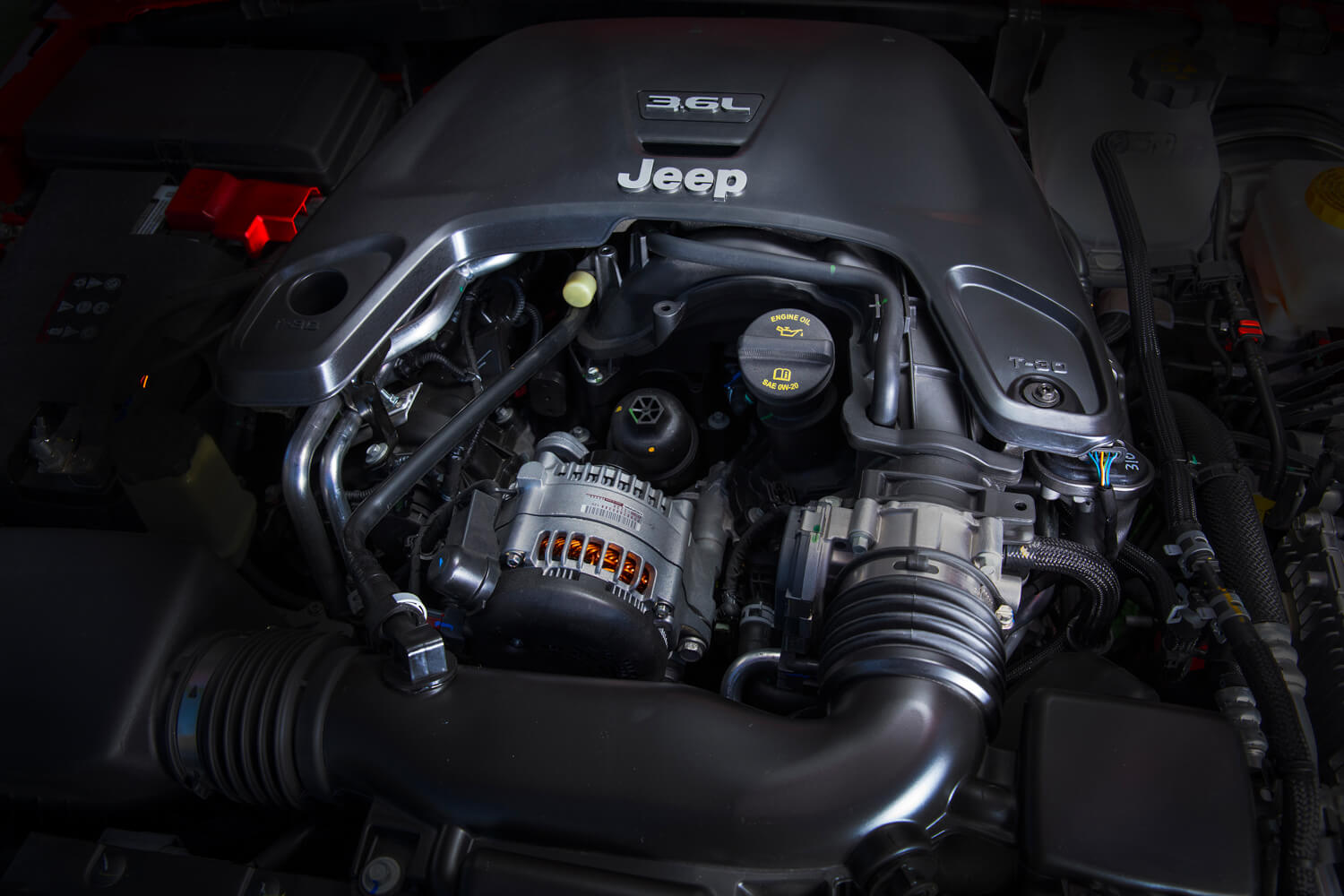
Under the feathery-light aluminum hood of the white Jeep was the proven 3.6-liter Pentastar V6, making 285 horsepower at 6,400 rpm and 260 lb-ft of torque at 4,800 rpm. It might be an old engine, but it’s still a good one.
On the Street
Modern 4x4s have become vastly easier vehicles to live with over rigs from even a decade ago. But that puts a thick layer of refinement between man to machine that can dull the driving experience. Jeep has done an impressive job improving the Rubicon while still retaining driver engagement. And part of that connection comes from providing mechanical control over the 4X4 functions. Jeep highlights that by creating a special section of the center stack with a bright red backing just for the locking diff switches. And right next door is the swaybar disconnect switch and a bank of four axillary switches.
But between these two test Wranglers, it is the manual transmission rig that feels most connected to the driver. There’s certainly something great about seeing side-by-side levers to control both the transfer case and the manual transmission. The six-speed unit in the Rubicon is easy to shift and the clutch is incredibly light. This is a pleasant transmission to live with around town or in heavy traffic because the gearshift slips into gear easily. It’s not a gearbox without faults, though. The shift knob itself is ridiculously chunky and not comfortable to use. And, when driven near the engine’s redline, the revs hang too long with the clutch depressed. That makes for rough gear changes unless you wait for the revs to drop.
Advantage: V6
The six cylinder is perfectly adequate. And it certainly isn’t slow around town—until you experience the turbo. The new turbo four-cylinder hits very hard once the revs climb to 3,000 rpm. It’s noticeably quicker in every measurement, except perhaps right off idle. The spunky four-cylinder transforms the Wrangler into a far sportier and far more entertaining machine.
The four-cylinder is quieter too. And that’s especially true on the freeway. On flat roads at 70 mph, the turbocharged Jeep would rev right at 2,000 in top gear. Small elevation changes and big hills alike would require exactly one downshift. The revs rise to 2,500 rpm and the turbo’s wave of torque would push it up and over the top of the grades, with torque to spare.
The manual transmission’s gearing was excellent on the highway too. At 70 mph in sixth, the V6 JL showed 2,100 rpm on the tach. And that was high enough in the rev range for flat sections and mild inclines. But several times we did have to downshift to fifth, which brought the revs up to 2,500 rpm. While both engines carry the same rpm on those grades, the four-cylinder is significantly quieter and seems to be doing less work.
Advantage: Turbo
On the rough roads of LA’s urban jungle, the ride quality in both Jeeps is excellent. The steering column vibration and shaking of the windshield frame that was common on the JK are gone. And, when the big 33-inch tires plow through the potholes on LA’s worst roads, little is felt in the cabin.
One thing both Jeeps have in common is that neither of them came close to their EPA fuel economy highway rating. Both of these Wranglers delivered at or under their EPA city rating. The V6 manual Rubicon only managed to return 17.6 mpg on our test loop. That’s basically right on top of the city rating. The four-cylinder turbo may have sipped fuel at a slightly better rate of 19.7 mpg. But that number was well under the EPA city rating. Still, the four-cylinder powertrain provided a two mpg boost on our route over the V6. Would a V6 equipped with the 8-speed automatic close that mpg gap? We’d have to test one to be sure.
Advantage: Turbo
The front Dana live axle in both Jeeps has a beefy 8.26-inch ring gear and uses an electrically-operated locking differential and 4.10:1 gears. A five-link coil-spring arrangement suspends the big axle. The front axle’s swaybar can be disconnected at the push of a button freeing up loads of wheel travel.
On the Trail
The Rubicon’s true personality as an off-road hero begins when those big BFGs touch dirt. The Rubicon sits tall, with 10.5 inches of clearance under the front diff and nearly the same amount under the rear one. Naturally, rock sliders are protecting the bottom edge of the rockers on both Wranglers too. The incredible clearance, the traction from those the beefy tires, and a flexy solid-axle suspension meant that many parts of the park were handled without even shifting the transfer case lever. But then, as we systematically engaged the Rubicon’s trail tools, the capability envelope widened dramatically.
Move the lever into low range and our twin Rubicons are more talented than all but a handful of 4x4s. Disconnect the front swaybar and both comfort and capability dramatically improve while traveling off-road. But there are differences between our two Wranglers. Thanks to the incredible gearing of that manual transmission and immediate low-end torque, we were able to slowly crawl up the hardest hill climb without locking an axle or slipping a tire. And the same thing happened in the automatic-equipped four-cylinder. We kept the engine revs right at 1,500 rpm and crawled right up with open diffs. However, the initial delivery of torque right off idle just wasn’t as strong in the four-cylinder.
If we had to pick one for the way up, the manual Rubicon felt like the true trail tractor of the two. It crawled effortlessly up that steep hill in first gear. And, it was controlled on the way down too. But, because manual transmission Rubicons don’t come with hill descent control, we did have to modulate the brakes ourselves. And yes, it was fun. We have to admit the turbo Jeep’s hill descent control modulates those brakes with so much more control. The Jeep creeps down without so much as slipping a tire—all at less than one mph. Of course, one could have that same hill descent control in an automatic V6 Wrangler.
Advantage: V6
In the sandy washes, the manual Jeep was great fun. Turn off the stability control, leave it in 2WD, and the Rubicon V6 is a total sand buggy. You can drift it, fishtail, or pile on some speed in four-wheel drive high range. The four-cylinder was oddly less able to handle the sand in 2WD. There are probably two reasons why. First, it delivers 35 extra lb-ft of torque much lower in the rev range, but that delivery is peakier. So, when you floor the throttle, not much happens and then everything happens. The Jeep spins the tires and digs down a bit. The other problem is that the added weight over the front tires of nearly 300 lbs. seems to make the nose of the Jeep plow a bit. All that changed when we pulled the lever into four high. When we did, the turbo Jeep was an animal. Pin the throttle and the Wrangler would shoot through the sand from corner to corner with quickness and precision. It’s just too much fun to deny. The sand wash test goes to the turbo.
Advantage: Turbo
In the rock garden, where to date we’ve only taken other Rubicons (and that giant Mercedes-Benz G500 4×4 Squared with 17-inches of ground clearance), both ‘Cons were right at home. We picked our way through the trail with a bit of rubbing and scraping and used the rear locker for the whole run in both Rubicons. But there was a little less trail rash on the four-cylinder turbo Jeep because the automatic made driving the blue Wrangler easier. However, we had way more fun creeping over boulders in the manual. The manual’s gearing is fantastic and the off-idle torque of the V6 felt like a great match. Here on these rocks, we preferred the company of the V6 and the manual transmission even though it required more driving skills.
Advantage: V6
Later, we hit the fire road over to our deeply rutted dirt mogul test section. The climb was particularly chewed up. But we were able to pick just about any line we liked with either of the two Jeeps with the front swaybar disconnected and open diffs. Locking both axles made the climb totally effortless without any wheel slip. The four-cylinder turbo, with its automatic transmission, again made for an easier climb—but it wasn’t as fun. Plus, unlike the rock garden, mistakes here don’t mean body damage. So, it’s more about the fun and challenge of picking tough lines. And, because the manual transmission has such deep gearing, you have amazingly controlled crawling at a near glacial pace. At these super-slow speeds, that manual provides a lot of smiles.
Advantage: V6
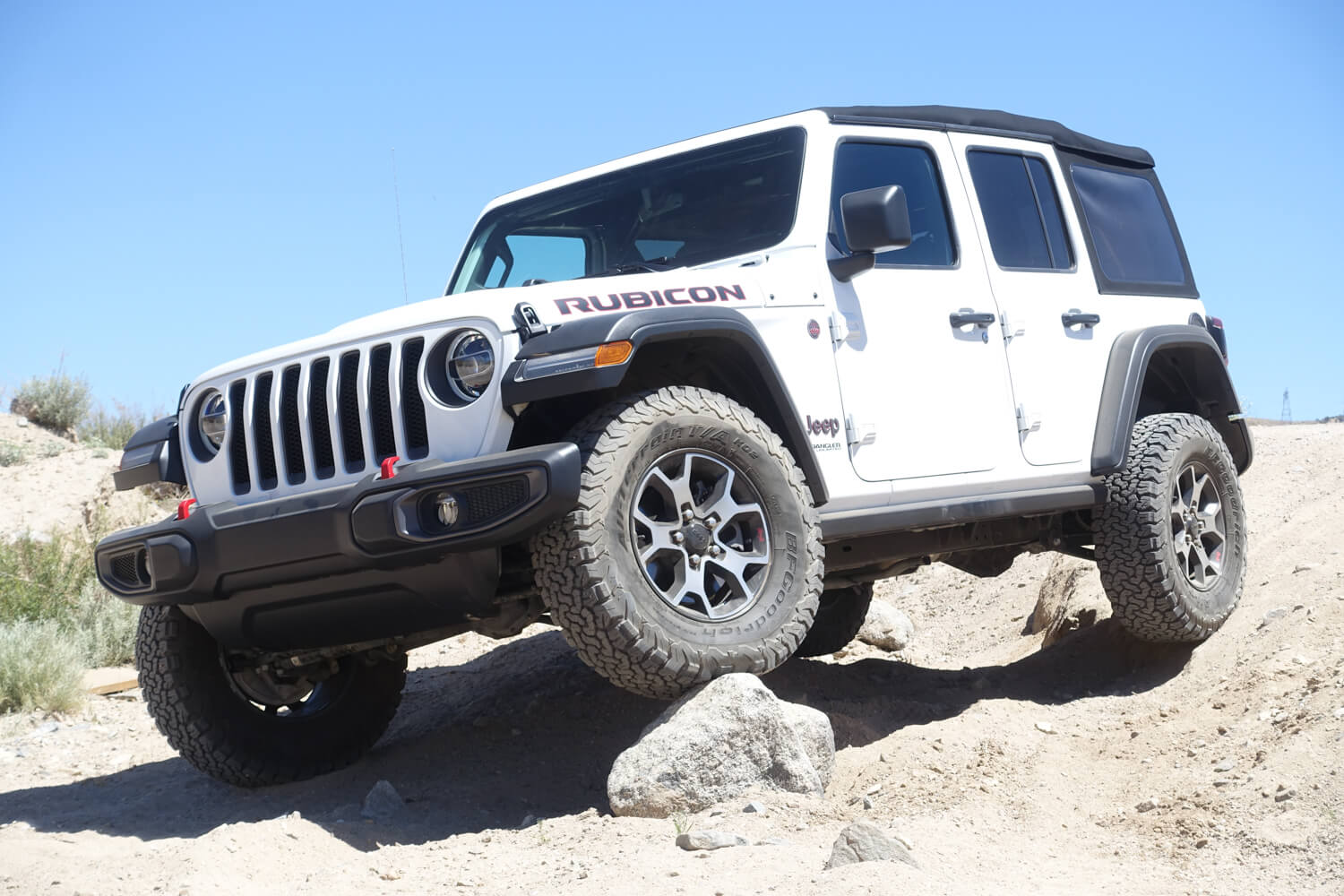
The Bottom Line
If we tally the results from these subjective tests, the V6 has the overall advantage with wins in four categories vs. three. But there are a few more things to consider. First, the turbo powertrain is a $3,000 upcharge over the manual V6. But if you use a V6 automatic as the bogey, the turbo costs $1,000 more. That’s still significant.
Next, the complexity of the turbo engine is undeniable. There’s plenty to go wrong with a pressurized engine on its own. But there’s even more potential for failure with the eTorque system. Which powertrain would you rather have under the hood of your JL when you’re driving on the trail hundreds of miles from the nearest town? There’s something to be said for simplicity. And, although we like the turbo motor better in many ways, the V6 is the safer and cheaper bet. Its reliability is known and will probably be less expensive to service as the miles pile on. For those reasons, we’d have to pick the V6 as our rig.




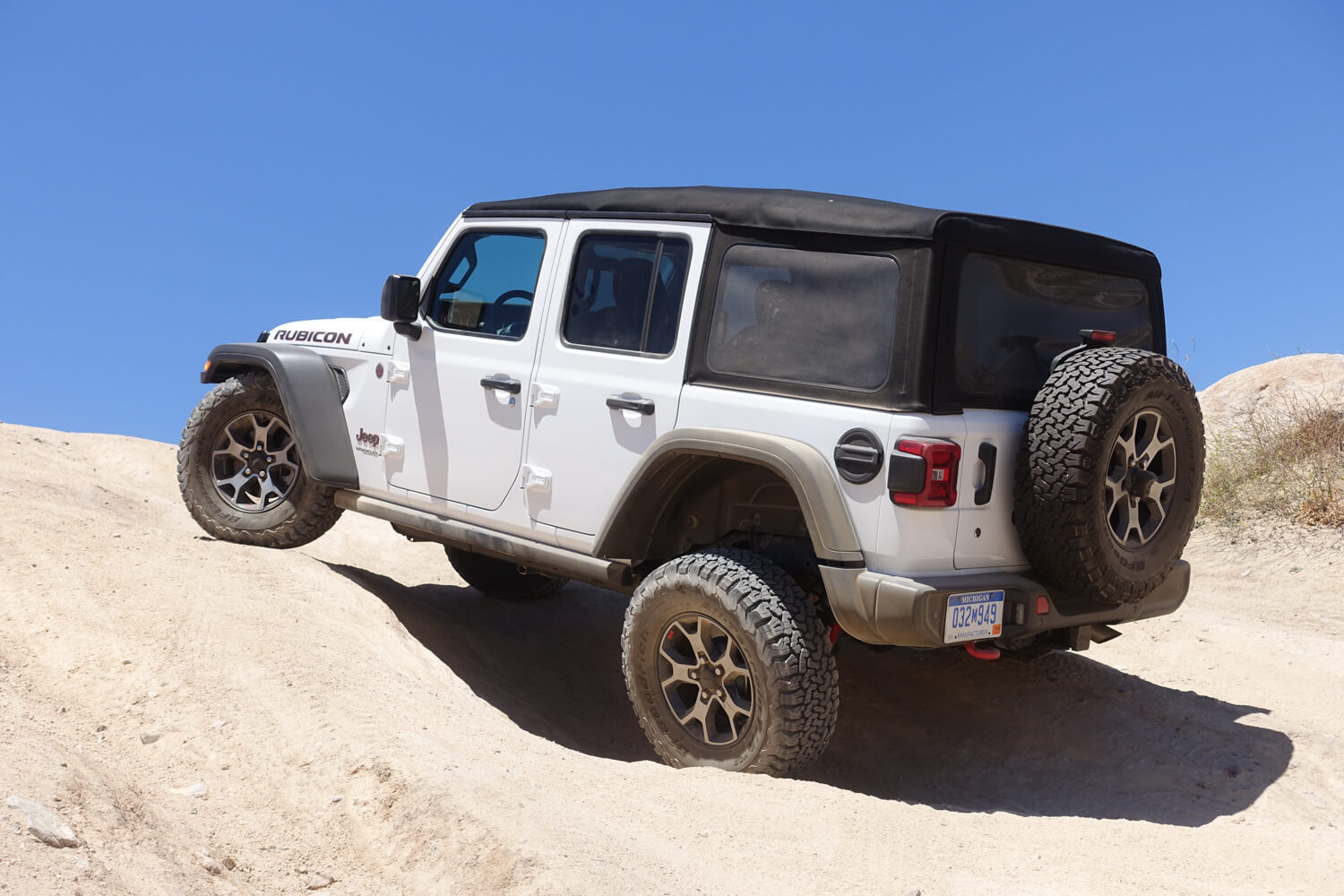
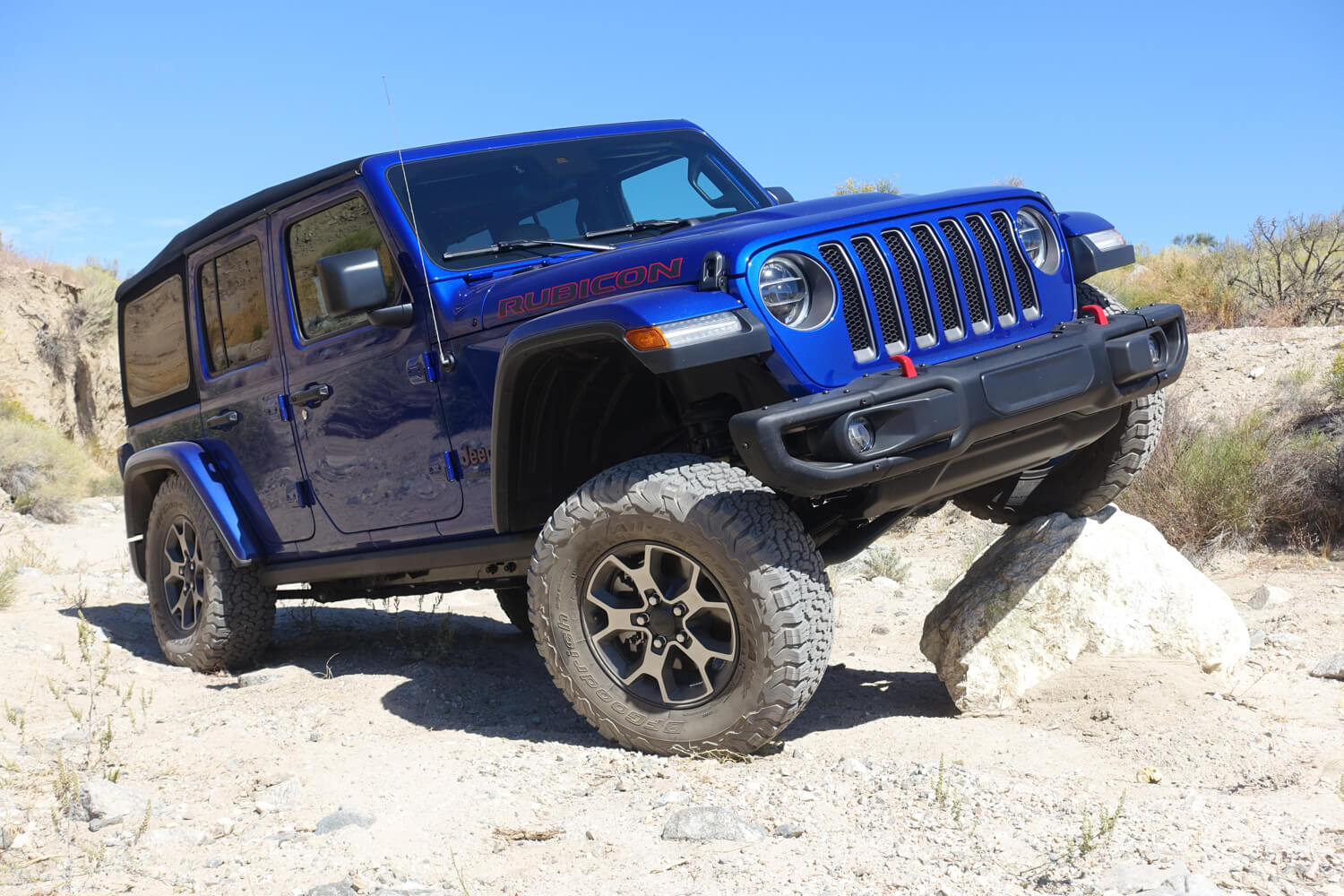
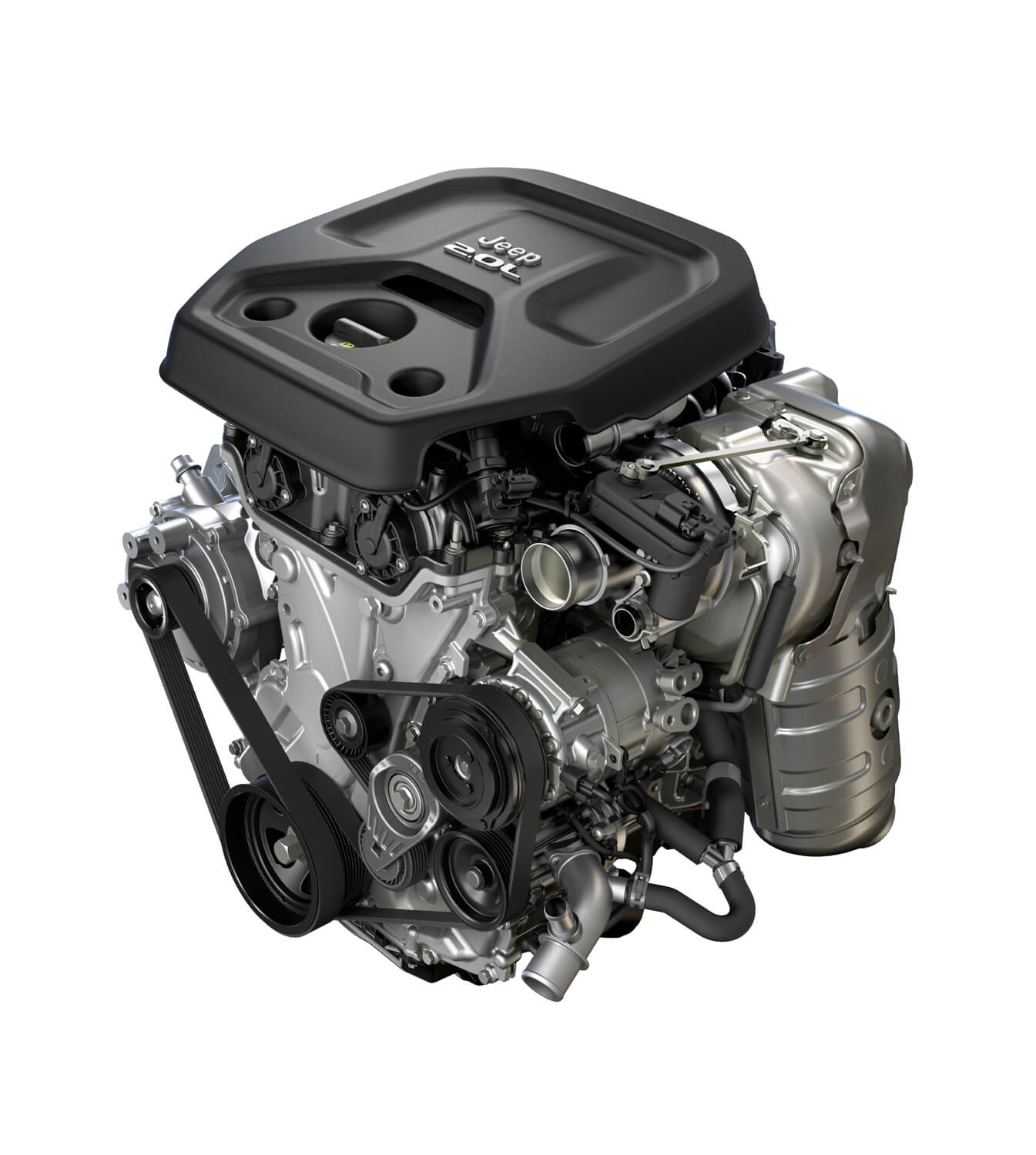
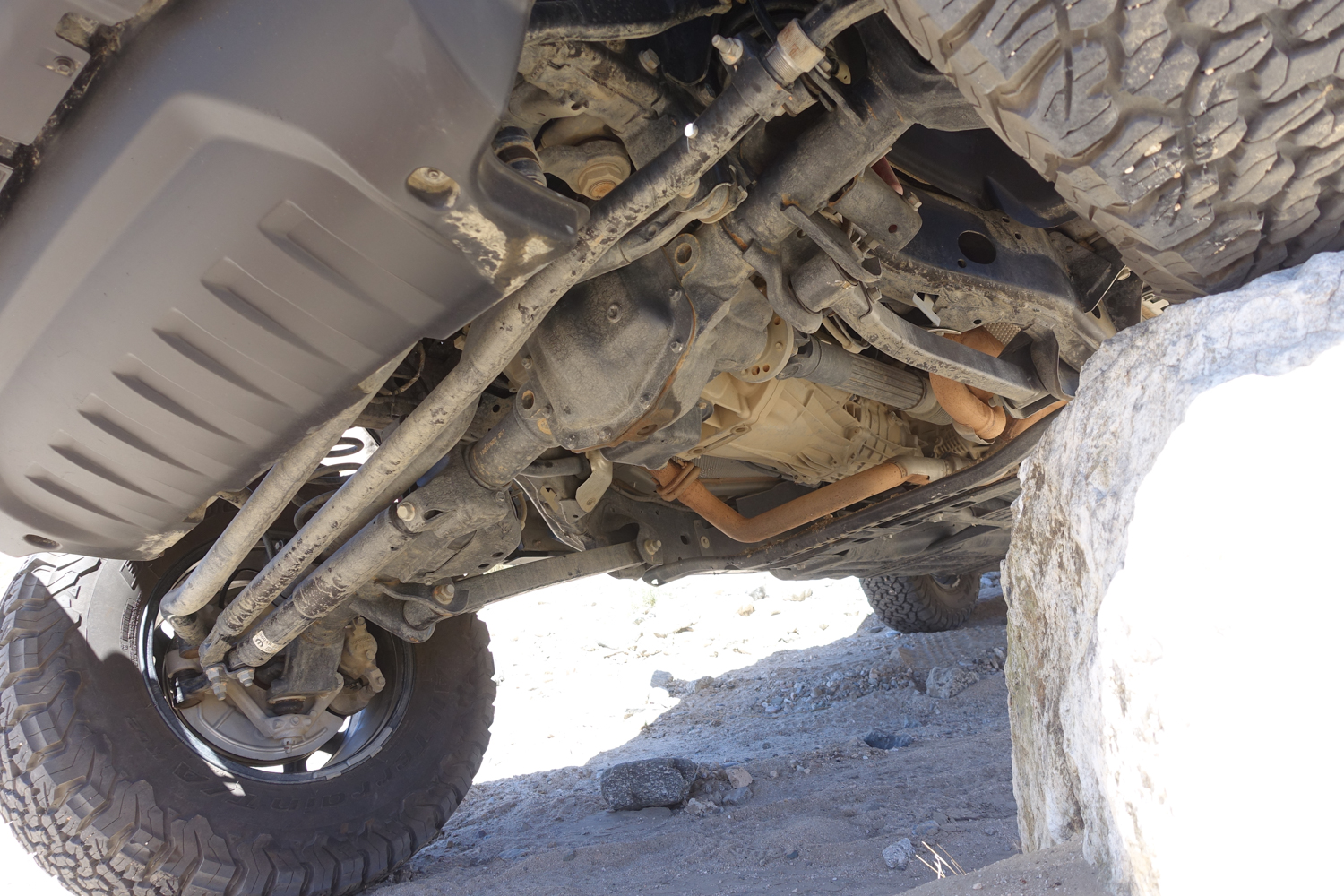
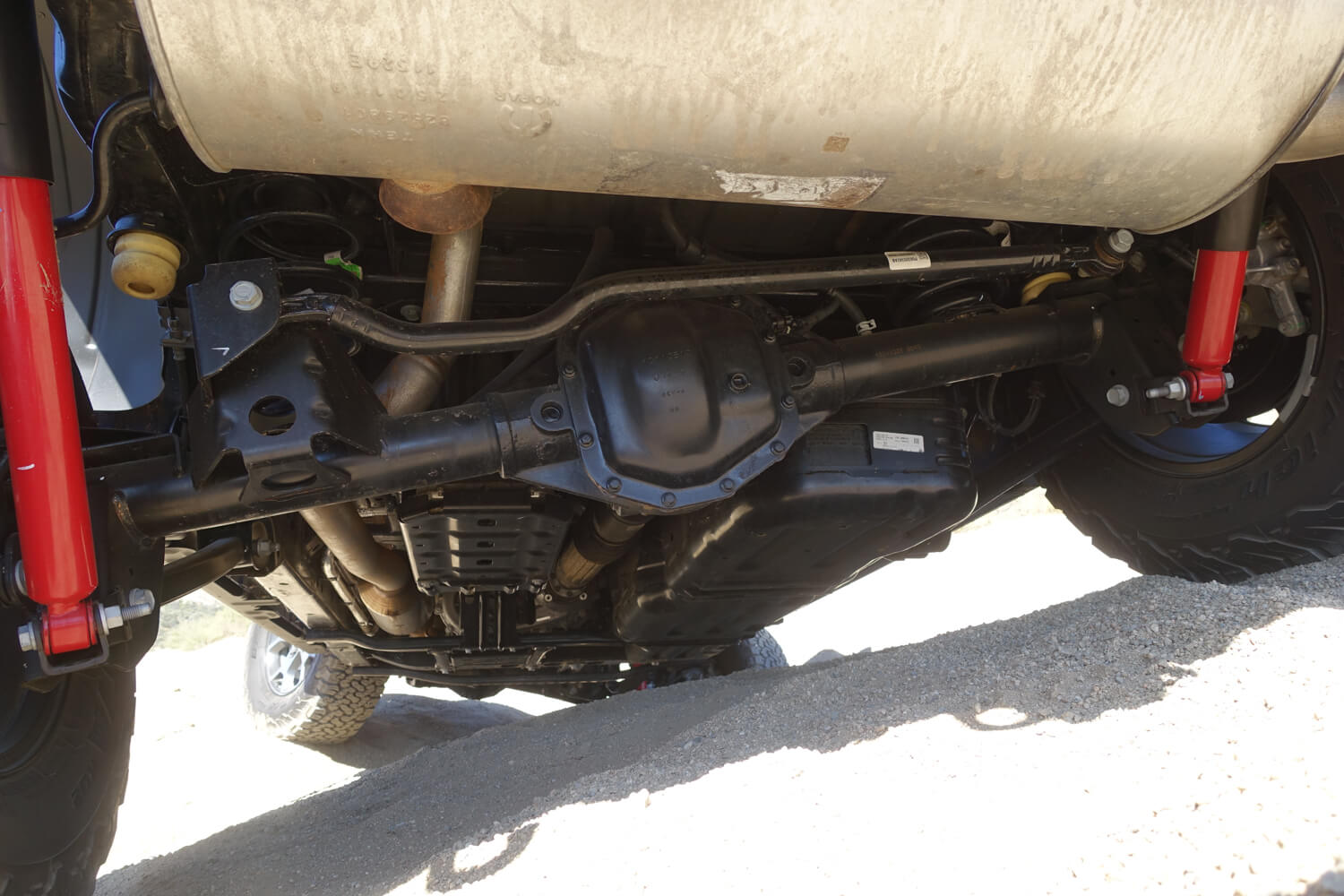
2